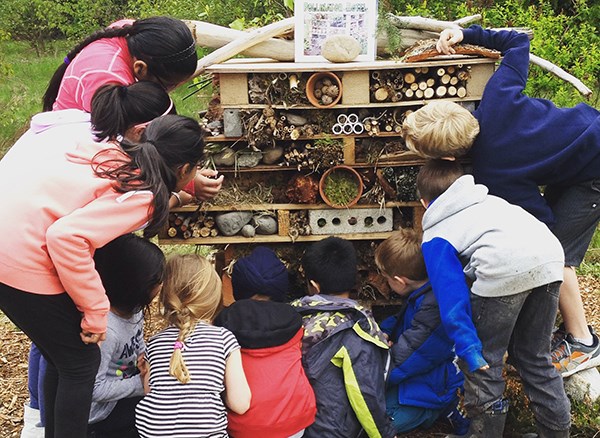Where some see a pest and a potential, painful sting, Michalina Hunter and Rhonda O’Grady see a cute and essential creature.
The pair hosted a mason bee workshop to about a dozen bee enthusiasts at the Squamish Public Library on May 16.
“We want to attract mason bees and other bees to our garden because it helps enhance our garden’s pollination and therefore the amount of fruits and vegetables we get,” said Hunter, who works with the Squamish Climate Action Network. “A well pollinated raspberry, for example, will be giant. All the balls on it will be fat and juicy, and a not-pollinated raspberry will be hard and not juicy and not filled out.”
Planting wildflowers around your garden is a good way to attract bees, Hunter said.
“They will pollinate your flowering garden plants,” she said.
Another way to attract bees is to supply them with a nest.
The mason bee is so-called because of its mason-like habit of using mud to make its home, Hunter said.
Hosting mason bees with a nest or house in the backyard is simple, according to Hunter and O’Grady. A mason bee abode can be made from a block of untreated cedar, for example. Drill holes into the block, making sure one end of the hole stays blocked. Line the holes with homemade paper tubes, which can be created by wrapping craft paper around a pencil, to allow the cocoons to be removed easily in winter. Finally, attach a roof to the block to protect the house from the rain.
A wooden stump with beetle holes can serve as a house, too.
That’s all you need to attract mason bees to come and nest, the women say.
For those who don’t want to make their own bee house, premade homes can be purchased online, as can mason cocoons, said O’Grady, who is an educator with the Squamish River Watershed Society.
She buys cocoons to ensure that when she works with classes of children, enough bees are available for them to handle come spring, she said.
Hunter explained the lifecycle of the mason bee: Adult bees come out of their nests in the early spring, they mate, the males die and the females gather pollen and head off to find a place to lay eggs. The female then puts a mix of pollen and nectar at the bottom of each cell for the growing egg to eat, then she blocks the hole with mud. After the eggs hatch, the larvae spin cocoons and develop into adults, which hibernate over the winter. The process starts over again in the spring, she said.
To protect them, O’Grady keeps the cocoons in a small box in her fridge over winter, but they can be kept in any cool, dry place, she said.
The first bees that emerge in the spring are males that don’t sting, so they can be easily handled, she said.
People who would rather not host bees can still help them, according to O’Grady, who described the bees as “so cute.”
“I don’t know if you have ever noticed a bee that looks very, very tired, on a flower, not moving and just sitting there – it is probably thirsty,” O’Grady said, adding a little water on the palm of the hand and taking it to the bee will revive it.
“It will feel better and fly away. Especially in the drought we are having, it is really important.”
A small dish with water and rocks – bees may drown in a dish of just water so they need rocks on which to walk – works well too, according to O’Grady.
O’Grady stressed that hosting bees is not a new idea.
“None of this is new. This is old stuff being recycled again – things we have forgotten, that we shouldn’t have forgotten.”
A mason bee kit for parents, educators or community groups is available at the Squamish library.




